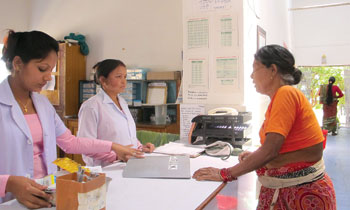Equitable, just, and quality healthcare is never free, it requires state investment
Recently the government announced it would be expanding its list of free medicines provided at district hospitals from the existing 40 to 60. But it is worth considering what ‘free’ actually means.
Someone always pays for life-saving medicines, the question is: who should pay and when? In Nepal, patients and their families pay at the time of illness. But user fees exacted at the point of care represent a deterrent to receiving effective care for the sick, especially if they are poor.

KUNDA DIXIT
One review of Nepal’s free healthcare policy showed that 85 per cent of hospitals suffered medication shortages. In the picture a patient receives medicine at Bayalpata hospital.
A study of seven African low-and middle-income countries that exempted patients from user fees found that there were immediate and significant increases in service utilisation. Here in Nepal, the post-conflict interim constitution integrated strong rights-based changes into the government’s approach to healthcare delivery that prioritised access for the poor.
A policy of free care at all health posts and sub-health posts and for 40 essential medicines at the district hospital level was adopted. Other services, such as deliveries, were not only provided free of charge, patients also received a small stipend to encourage use of those services.
One study covering Bardiya, Dailekh, and Jumla showed that there was a 215 per cent increase in patients in health posts and 133 per cent increase in sub-health posts. Decreasing the financial burden patients and their families incur with ‘user fees’ has led to increased service utilisation across the board.
This supports the case for society-at-large via the government bearing the cost of essential medical care. There are no ways to avoid this should we truly value having a deep and reliable social safety net. The expansion of the essential medicines list is a step in the right direction, but its deeper impact remains to be seen. The new mandate on the right to free healthcare has, unsurprisingly, been difficult to translate into actual advances in the right to health for Nepal’s excluded populations. Much of this has to do with the inherent challenges of delivering care to the poor and excluded.
Fifty-five percent of the richest quintile births take place in a healthcare facility, compared with only four per cent of the poorest. One review of Nepal’s free healthcare policy showed that 85 per cent of hospitals suffered medication shortages and 24 per cent of healthcare facilities were understaffed owing to absenteeism and competing work by staff in the private sector.
Improving these realities is made difficult by patterns of healthcare utilisation in the post-free care era: 84 per cent of the poorest quintile utilised public sector services and 10 per cent went to the private sector, compared with 64 per cent and 29 per cent in the highest. Wealthier individuals going to private sector facilities tend to have more socioeconomic means to advocate for improved services and so the accountability of the public sector suffers. Government hospitals and clinics throughout Nepal therefore remain woefully under-staffed, under-resourced, and under-supplied.
How would more medicines in this context be beneficial? A mobilised citizenry and empowered patient population, aided by more transparent data, are needed to improve government services. This requires a virtuous cycle: public sector services are more accessible, comprehensive, and professional, leading to greater citizen engagement and patient utilisation. Expanding the accessibility and reach of public sector services via expanded access to medicines can help facilitate this cycle.
The more that the public sector offers, the more patients will utilise them, the more patients utilise services, the more they demand them. The more they demand the services, the better the government should deliver on them.
Yet achieving equitable, just, and excellent healthcare outcomes is never free. It requires active investment from a state and its citizens. Nepal has been a global leader in commitments to and innovations in the kinds of investments required. It has demonstrated leadership on innovations in delivering on a robust social safety net with the female community health volunteer network, existing essential medicines program, and safe motherhood initiatives.
Mechanisms to finance essential medicines need to be further developed to ensure that declarations on paper get translated into effective supply chains that reach the most remote communities.
These investments do cost money, but they offer tangible steps towards making Nepal a more healthy and just nation.
Duncan Maru is co-founder of Nyaya Health which works in a private-public partnership with the Nepal government to provide healthcare at Bayalpata Hospital in Achham. Roshan Bista is a staff physician at Bayalpata Hospital.
Read also:
Holding up half the district
Crowdfund globally, act locally